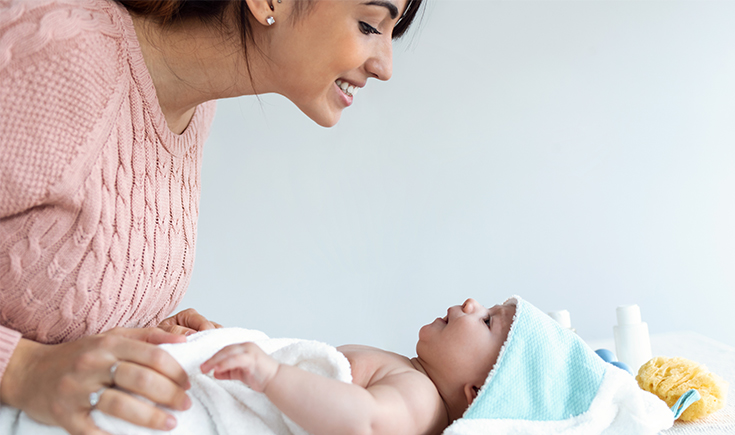

Your baby’s beautiful, kissable, soft, and sweet-smelling skin is incredibly sensitive, so it can easily become prone to dryness. Dry skin in babies is usually nothing to worry about, and managing it is simple when you know how.
Read on to find out what causes dryness in baby skin, what it looks like, how to tell the difference between dry skin and something like eczema that may need a different treatment, and finally our five tips to managing it.
What causes dry skin in babies?
Dry skin is very common in children, and has many causes, including:
- Dry environments. A climate with low humidity, exposure to cold temperatures (particularly as we move into cooler weather), air-conditioned homes, or close contact with a fireplace or heater.
- Bath products. Some soap or bubble bath products can remove the skin’s natural oils, which makes it harder to keep the moisture in.
- Bath temperature and frequency. Bathing in water that’s too warm or bathing too often.
- Clothing or bedding. Rough towels, clothes, or bedding, or irritating laundry detergent of fabric softeners.
What does dry skin look like?
Babies (and adults) will get a bout of dry skin from time to time, and it can come up anywhere on the body. In babies, it’s commonly seen on their arms, face, feet, legs, and lips. Symptoms include:
- Dull, flaky, rough, ashen patches
- Fine lines or cracks if it’s very dry
- It usually isn’t itchy unless it becomes very dry, which can lead to scratching and further irritation
- If the dryness becomes serious, the skin may bleed or become infected. This is when you might see crusting, oozing, redness in lighter skin, and brown, purple, or grey in darker skin.
How to tell the difference between dry skin and eczema
Dry skin and eczema can have some symptoms in common. Here’s how you may be able to tell the difference, but always talk to your GP if you’re unsure because it affects every child differently:
- Eczema doesn’t just flare up in cold or dry conditions, but you might notice bub’s skin gets irritated from milk or saliva.
- Unlike dry skin, you might find eczema in less typical places on the body, such as in the creases of the elbows, behind the knees, behind the ears, or on their scalp.
- Skin with eczema can look inflamed, and may also develop little fluid filled pimples.
How to manage your baby’s dry skin: 5 simple tips
The best way to manage your baby’s dry skin is to manage the underlying causes. If their dry skin doesn’t improve with the following treatments, or it becomes worse, please see your baby’s doctor. They may suggest certain moisturisers or bath washes, or refer you to a dermatologist.
1. Keep bathtime short and warm (not hot)
Ensure the bath temperature is close to lukewarm if possible (heat the bathroom instead in the cooler weather), and only use a small amount of natural, soap-free bath wash. It doesn’t even need to be daily, and you could use plain water on the other days. Use a soft towel to pat dry their skin after the bath.
2. Moisturise, moisturise, moisturise
After the bath, use a thick, hydrating, fragrance-free, non-irritating moisturiser. Reapply once or twice throughout the day and before bed. You might need to add more moisturiser to their face and lips when you go outdoors on a cold day. Use cotton cloths to gently wipe a runny nose or pat away any drool.
3. Adjust the indoor conditions
Make the air less dry by using a cool air humidifier, fans instead of long periods of air-conditioning use, and minimise close contact with heaters. A cooler room overnight is best for avoiding overheating (which is also a SIDS risk).
4. Dress your baby for the environment
When indoors, dress your baby in loose, breathable cotton clothing, and when heading outdoors, add the appropriate layers to reduce exposure to cold, dry air. For instance, you may need a hat and gloves to protect their skin from the elements.
5. Keep them hydrated
Even during the cold months, babies need to be kept hydrated. Make sure they get plenty of fluids from breastmilk or formula. Offer cooled boiled water after six months when necessary.























